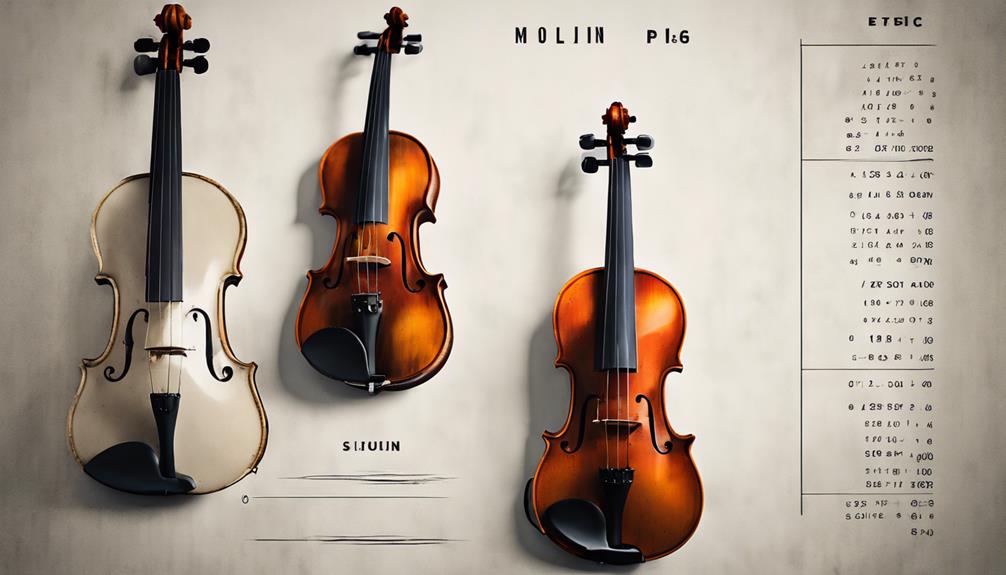Explore the violin size chart for precise selection based on your age and arm length. Different sizes like 1/16 to 4/4 cater to various stages and builds. Measuring from neck to palm aids in the accurate size match. Assessing body length ensures comfort during play. By interpreting the chart components, find the perfect fit by aligning with measurements. Corresponding age with size correlates to comfort and skill improvement. Ensure a hands-on approach by testing various sizes with professional guidance. Enhance your playing journey by discovering the ideal violin size through proper measurement and interpretation.
Different Violin Sizes

When it comes to understanding different violin sizes, it is essential to grasp the notation used to categorize them, such as 1/16, 1/10, 1/8, 1/4, 1/2, 3/4, and 4/4 (full size). Each size represents a specific length and scale tailored to the player’s age and arm length, ensuring comfort and ease of play. As players progress in skill and physical growth, they typically advance through the sizes, from smaller to larger violins, until they reach the full-size instrument for adult players.
Explanation of violin size notation
When selecting a violin, it is essential to understand the notation used to indicate different sizes. Violins come in fractional sizes, including 1/16, 1/10, 1/8, 1/4, 1/2, 3/4, and 4/4. These fractions represent the scale of the instrument, with 4/4 being full-sized and the others decreasing proportionally.
Fractional sizes (1/16, 1/10, 1/8, 1/4, 1/2, 3/4, 4/4)
In the world of violins, fractional sizes are denoted using numerical fractions such as 1/16, 1/10, 1/8, 1/4, 1/2, 3/4, and 4/4 to indicate the varying sizes available for players of different ages and physical builds. Choosing the right fractional size offers benefits like improved comfort and posture. Proper fitting techniques involve measuring arm length and considering the player’s age to ensure optimal playability and sound quality.
Size progression and typical usage
As a beginner, young children usually start with the 1/16 or 1/10 size violins, while older children typically progress to the 1/8, 1/4, or 1/2 size instruments. Adults commonly use the 4/4 (full size) violins, which are suitable for most advanced players. Understanding the size progression and typical usage ensures that players of all ages can find the right fit for their skill level and comfort.
Young children, older children, and adults
For young children, older children, and adults, the progression of violin sizes typically starts with the smallest size and increases as the player grows in size and ability. Parent involvement in selecting the appropriate size is crucial. Establishing consistent practice routines aids in skill development. Additionally, understanding instrument care and maintenance tips is essential to ensure the longevity and optimal performance of the violin.
Measuring for Violin Size
To determine the appropriate violin size for you, start by measuring your arm length from the neck to the center of the palm. Next, measure the length from your neck to your wrist to find the correct body length needed for comfortable playing.
Arm length measurement
To accurately measure for the correct violin size, start by determining your arm length. Measure from the base of your neck to the middle of your palm for an accurate reading. This measurement will help you select the appropriate violin size based on your arm length.
Step-by-step guide to measure arm length
Begin by placing the tape measure at the base of your neck, then extend it down your arm to the wrist for an accurate measurement of your arm length. To ensure a proper technique, keep your arm straight and relaxed during the measurement. Remember, maintaining instrument care is crucial; avoid touching the violin with the measuring tape to prevent any accidental damage. This precise process will help determine the correct violin size based on your arm length.
How to use arm length to determine violin size
Start by utilizing your arm length measurement to accurately determine the appropriate violin size for you. For adult beginners, this step is crucial in ensuring comfort and ease of play. Custom fittings may be necessary for those with unique arm lengths. Measure from the neck to the middle of your palm for an accurate size assessment. This precise method guarantees a well-suited violin size for optimal performance and learning.
Body length measurement
To measure for the correct violin size based on body length, stand straight with your arms relaxed at your sides. Use a measuring tape to measure from your neck base to the middle of your left-hand palm, as this will be your body length measurement. Make sure to cross-reference this measurement with your arm length measurement to ensure you select the right violin size for a comfortable playing experience.
Step-by-step guide to measure body length
To measure the body length for the appropriate violin size, use a measuring tape or ruler on the back of the instrument from the base of the neck to the center of the lower bout. Achieving measuring precision is crucial for sizing accuracy, ensuring instrument comfort, and enhancing musical performance. This step-by-step guide guarantees accuracy in determining the correct violin size based on the player’s body length.
Cross-referencing arm and body measurements
When determining the appropriate violin size, it is essential to cross-reference arm and body measurements to ensure optimal comfort and playing experience. Size customization plays a crucial role in finding the right fit. By accurately measuring body length and arm span, you can determine the ideal size. Additionally, fitting accessories such as shoulder rests and chin rests need to complement the chosen violin size for a comfortable and enjoyable playing experience.
Interpreting the Violin Size Chart

When interpreting the violin size chart, it’s crucial to understand how to read the measurements accurately. A sample violin size chart can provide a visual representation of the different dimensions to help you select the right size for your needs. Ensure to pay close attention to the specific measurements outlined in the chart to make an informed decision on the appropriate violin size.
How to read a violin size chart
When interpreting a violin size chart, pay close attention to the components listed such as the player’s arm length and age. Match these measurements accurately to the chart to determine the correct violin size needed. Understanding these key points will ensure you select the appropriate violin size for the player’s comfort and musical development.
Explanation of chart components
To effectively interpret the violin size chart, examine the specific measurements provided for each size category. The chart interpretation involves understanding visual representations for size selection and comparison. Pay close attention to measurements such as the length of the back, body length, and playable string length. These details offer a precise guide for selecting the appropriate violin size based on the player’s age and arm length, ensuring a comfortable and optimal playing experience.
Matching measurements to the chart
To accurately interpret the violin size chart, carefully match the specific measurements provided in the chart to the corresponding size categories, focusing on details such as back length, body length, and playable string length. Tips for parents include measuring from the neck to the middle of the left-hand palm for accurate sizing. Common mistakes involve solely relying on age instead of physical measurements, leading to an ill-fitting instrument.
Sample violin size chart
When examining a sample violin size chart, you will see common measurements such as the length from the scroll to the end button, as well as the width of the body. These measurements correspond to specific violin sizes, helping you determine the right fit for your playing needs. By understanding how to interpret these measurements on the chart, you can make an informed decision when selecting the appropriate size violin.
Displaying common measurements and corresponding sizes
Understanding the sample violin size chart can provide a clear representation of the common measurements and corresponding sizes for different violin sizes. This chart allows for violin size comparison, showing the size variation between instruments. It also includes size conversion information for international sizes, aiding in selecting the right violin size based on the player’s measurements and needs. The chart serves as a valuable tool for accurately determining the appropriate violin size.
Age and Violin Size Correlation
As you progress in age and skill level, understanding the typical size recommendations by age becomes crucial in selecting the right violin. Factors like growth considerations also play a significant role in determining the appropriate instrument size for young players. By correlating age with violin size, you can ensure a comfortable and effective learning experience for aspiring musicians.
Typical size recommendations by age
When considering violin sizes for different age groups, it’s crucial to match the instrument’s dimensions with the player’s physical proportions. Recommended sizes typically range from 1/16 for very young children to full size for adults and older teens. Understanding the correlation between age and violin size ensures optimal comfort and playing experience.
Recommended sizes for different age groups
Determining the appropriate violin size for a player involves matching the instrument to the player’s age and arm length to ensure comfort and proper technique. Parental guidance is crucial for younger players, with size recommendations typically starting at 1/16 for ages 3-5 and progressing to a full-size violin around age 11. Adult beginners may need size adjustments based on their arm length and comfort level to find the right fit.
Growth considerations
As a young musician grows, their violin size may need adjustments to ensure proper playing posture and comfort. Knowing when to re-measure and upgrade to a larger size is crucial to support their musical development. It is essential to consider growth spurts and age-related changes when determining the appropriate violin size for a student.
Adjusting for growth spurts
To accommodate growth spurts in young violin players, it is crucial to regularly reassess and adjust the size of the violin they are using. Parental involvement and growth tracking are essential in this process. When shopping for new violin sizes, budget considerations play a significant role. It is important to select a violin that fits the child’s current size while also allowing room for growth to avoid frequent upgrades.
When to re-measure and adjust size
When considering when to re-measure and adjust the size of a violin for a young player, it is important to take into account their age and the corresponding recommended violin size based on growth considerations. Re-measuring frequency should occur every 6-12 months to ensure proper sizing. Size adjustments should be made promptly to maintain size flexibility and player comfort, avoiding strain or difficulty in playing due to an ill-fitting instrument.
Trying and Testing Violin Sizes

To ensure you find the right fit, it is crucial to try various violin sizes before making a decision. Seeking professional guidance during this process can help you determine the most suitable size based on your comfort and playing style. Remember, the correct violin size enhances your playing experience and overall performance, so take your time exploring different options.
Importance of trying different sizes
When selecting a violin size, it is crucial to engage in practical testing to ensure comfort and playability. By trying out different sizes, you can determine which one allows for proper posture and ease of reaching notes. This hands-on approach is essential in finding the ideal violin size that enhances your playing experience.
Practical testing for comfort and playability
Testing different violin sizes is crucial in determining the most comfortable and playable option for the musician. Comfort assessment involves checking the shoulder rest, chin rest, and overall feel of the instrument. Playability testing includes assessing the reach of the fingers on the fingerboard, the ability to shift positions easily, and the comfort of bowing. Trying various sizes ensures that you find the optimal fit for your playing style and physical comfort.
Professional guidance
When seeking professional guidance for selecting the right violin size, it is crucial to consult with a knowledgeable violin teacher or luthier. These experts can provide valuable insights based on your body size, arm length, and playing technique. Properly testing a violin size involves assessing comfort, reach, and sound quality to ensure the instrument suits your needs and enhances your performance.
Seeking advice from a violin teacher or luthier
Consulting with a seasoned violin teacher or experienced luthier is crucial when determining the appropriate violin size for your needs. Luthier recommendations and teacher insights are invaluable in navigating sizing challenges. Their expert guidance can help you avoid common pitfalls and ensure that the violin you choose fits you comfortably, allowing for proper technique development and overall enjoyment of playing.
How to properly test a violin size
Before purchasing a violin, it is essential to follow professional guidance on how to properly test the instrument’s size to ensure optimal comfort and playability. Utilize proper sizing techniques such as measuring arm length and consulting with a violin teacher or luthier. When testing comfort levels, pay attention to the position of your hand on the neck, the reach to the scroll, and the angle of your arm for a snug fit.
Frequently Asked Questions
Can Adults Play on Smaller Violin Sizes?
Yes, adult beginners can play on smaller violin sizes, but it’s crucial to consider the comfort and playability. Small violins can be suitable for adult players, especially those starting out, as they offer a manageable size for learning.
Are There Any Specific Violin Sizes for Left-Handed Players?
If you’re a left-handed player, certain techniques might feel more natural. When it comes to violins, there are customized options available to accommodate your needs. Consider exploring these tailored solutions for optimal performance.
What Is the Average Lifespan of a Violin?
Maintaining your violin is key to its longevity. With proper care and maintenance, a violin can last for centuries. Historically, violins have significant lifespans, showcasing the craftsmanship and durability of these instruments.
Can a Child Learn on a Full-Size Violin?
You can learn on a full-size violin as a child, but it’s crucial to consider physical limitations. Smaller sizes are often recommended due to child capabilities. Assess comfort and playability to ensure optimal learning experience.
Are There Any Health Benefits to Playing Different Violin Sizes?
Playing different violin sizes can offer health benefits. Smaller sizes promote improved posture for beginners, reducing strain. As players progress, transitioning to larger sizes can enhance mental focus due to increased complexity, stimulating cognitive development.
Conclusion
In conclusion, using the violin size chart is essential in determining the appropriate instrument for a player based on their age and arm length. By accurately measuring and interpreting the chart, players can ensure they have a violin that is comfortable and suitable for their size. Trying and testing different sizes is also important to find the perfect fit and ensure optimal playability and sound quality.

Lisa Maiers, a seasoned musician and dedicated music educator, brings her wealth of knowledge and passion for string instruments to the forefront in her latest guide, “Best Violins for Beginners.” With years of experience nurturing budding violinists, Lisa understands the critical role that the right instrument plays in a student’s musical journey. In this comprehensive guide, she offers invaluable insights and expert recommendations, helping beginners and their families make informed choices that foster growth, confidence, and a lifelong love of music. Whether you’re a parent seeking the perfect violin for your child or an adult embarking on a new musical adventure, Lisa’s expertise will guide you every step of the way.
